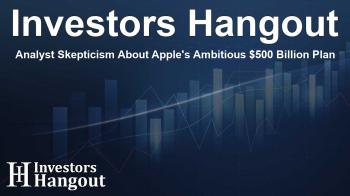Analyst Skepticism About Apple's Ambitious $500 Billion Plan

Apple's $500 Billion Investment Plan Under Scrutiny
Apple Inc. (NASDAQ: AAPL) has unveiled an ambitious plan to invest $500 billion in the U.S., a move that has created ripples within the investment community. However, not everyone is convinced. Analyst David Vogt from UBS has raised substantial concerns about the viability of this investment.
Concerns Over Feasibility
Vogt's skepticism stems from a detailed analysis of Apple's current operational structure. In his recent communications with investors, he pointed out that only about 10% of Apple's supply chain currently operates within the United States. The majority of its manufacturing and supply operations are heavily concentrated in Asian regions, particularly Taiwan and China.
Timeframe and Supply Chain Considerations
Reflecting on the progress Apple has made over the years, Vogt noted that it took the tech giant nearly a decade to achieve this relatively small percentage of domestic supply chain operations. He indicated that despite the shiny appeal of the investment figure, the reality lacks depth when considering Apple's historical commitment to U.S.-based operations.
Financial Viability Questions
Financial viability is another major hurdle highlighted by Vogt. Hiring additional personnel to support this expansion could incur an estimated $5 billion in operating costs each year. Coupled with Apple's existing annual data center costs of approximately $10 billion, the financial infrastructure to support such a hefty investment appears shaky.
Free Cash Flow and Share Buyback Implications
Apple currently enjoys about $100 billion in free cash flow but allocates a significant portion, around $90 billion, towards share buybacks. These figures bring into question how the company plans to fund the additional $125 billion needed annually for this new investment initiative. Reducing share buybacks seems implausible, leading Vogt to label the entire $500 billion investment plan "completely unrealistic mechanically."
Past Investment Announcements and Future Expectations
Historically, Apple has announced other significant investments, including a commitment to contributing $350 billion to the U.S. economy in a previous announcement, followed by an even larger pledge of $430 billion two years later. These investments align with strategic goals that emphasize Apple's manufacturing footprint and compliance with federal incentives.
Market Reactions and Analyst Opinions
In response to the recent plans, analysts have expressed mixed feelings. For instance, Dan Ives from Wedbush Securities views the announcement as a strategic alignment with governmental priorities regarding U.S. investment. Conversely, James Chanos, a well-known short-seller, voiced similar skepticism about the investment's realism, citing Apple's current capital base falling below $160 billion.
Potential Savings from Tariffs and Investment Increases
On the other hand, some analysts like Gene Munster from Deepwater Management appear more optimistic about the situation. Munster believes that Apple could potentially see an annual increase in U.S. investments by about $39 billion, although he realistically suggests that the actual incremental investment might be closer to $20 billion per year. The avoidance of tariffs could also lead to significant savings for Apple, estimated at nearly $11 billion annually, helping offset some of the associated costs.
Conclusion: A Balancing Act Ahead
Overall, Apple's proposed investment of $500 billion in the U.S. appears to be a double-edged sword. While it showcases a commitment to growth and development within the country, the logistical and financial challenges raised by analysts like Vogt complicate the narrative. For now, Apple stands at a crossroads, where successful execution of their strategy will depend on carefully navigating these complexities.
Frequently Asked Questions
What is Apple's $500 billion investment plan about?
Apple's investment plan aims to significantly boost its operational presence in the U.S., but it has been met with skepticism regarding its feasibility.
Why do analysts doubt Apple's investment plan?
Analysts question the plan's practicality due to Apple's limited domestic supply chain and its substantial annual operating costs.
What percentage of Apple's supply chain is U.S.-based?
Currently, only about 10% of Apple's supply chain operates within the U.S., with most operations based in Asia.
How does Apple's free cash flow relate to the investment plan?
Apple generates over $100 billion in free cash flow, but significant portions are allocated towards share buybacks, raising questions about funding the new investment.
Are there any precedents for Apple's large investments?
Yes, Apple has made previous commitments, including a $350 billion investment in 2018 and a $430 billion pledge shortly afterward, reflecting ongoing strategic initiatives.
About The Author
Contact Olivia Taylor privately here. Or send an email with ATTN: Olivia Taylor as the subject to contact@investorshangout.com.
About Investors Hangout
Investors Hangout is a leading online stock forum for financial discussion and learning, offering a wide range of free tools and resources. It draws in traders of all levels, who exchange market knowledge, investigate trading tactics, and keep an eye on industry developments in real time. Featuring financial articles, stock message boards, quotes, charts, company profiles, and live news updates. Through cooperative learning and a wealth of informational resources, it helps users from novices creating their first portfolios to experts honing their techniques. Join Investors Hangout today: https://investorshangout.com/
The content of this article is based on factual, publicly available information and does not represent legal, financial, or investment advice. Investors Hangout does not offer financial advice, and the author is not a licensed financial advisor. Consult a qualified advisor before making any financial or investment decisions based on this article. This article should not be considered advice to purchase, sell, or hold any securities or other investments. If any of the material provided here is inaccurate, please contact us for corrections.

